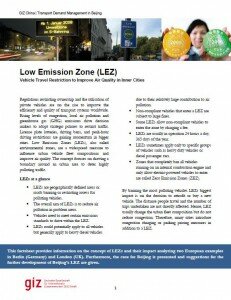 As a continuation of traffic restricting measures introduced during the Olympic Games in 2008, the municipal government of Beijing strictly banned heavy polluting vehicles from driving inside of the capital’s 5th ring road. The heavy-polluting vehicles are vehicles that fail to meet the Euro I emission standard, which China adopted as “China I” in 1992. Generally they are referred to as “yellow-label vehicles”. According to the Beijing Environmental Protection Bureau, a single yellow label vehicle generates emissions equal to that of 28 low-emission Euro IV-compliant vehicles.
As a continuation of traffic restricting measures introduced during the Olympic Games in 2008, the municipal government of Beijing strictly banned heavy polluting vehicles from driving inside of the capital’s 5th ring road. The heavy-polluting vehicles are vehicles that fail to meet the Euro I emission standard, which China adopted as “China I” in 1992. Generally they are referred to as “yellow-label vehicles”. According to the Beijing Environmental Protection Bureau, a single yellow label vehicle generates emissions equal to that of 28 low-emission Euro IV-compliant vehicles.
In October 2009, 10 months after the introduction of the yellow-label vehicle ban, the restricted area was extended to Beijing’s 6th ring road. Reducing the number of heavy-polluting vehicles is one of the city’s top priorities until today and different measures are undertaken to clean up the air in Beijing. Among others, it is discussed to further develop the existing Low Emission Zone (LEZ) beyond yellow-label vehicles.
Different cities across the world have introduced LEZ to manage air quality in urban areas. Well-known examples include the “London Low Emission Zone” and the “Umweltzone” implemented in many German cities such as Berlin. A newly released factsheet further investigates these two examples and the success factors of each policy. The lessons learned from this analysis are used to present a potential development path for Beijing and gives recommendations to enhance Beijing’s current LEZ.
Download the factsheet here:


